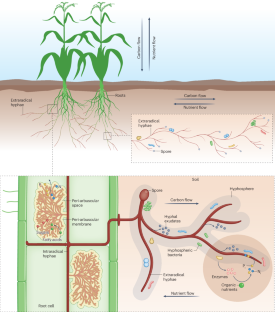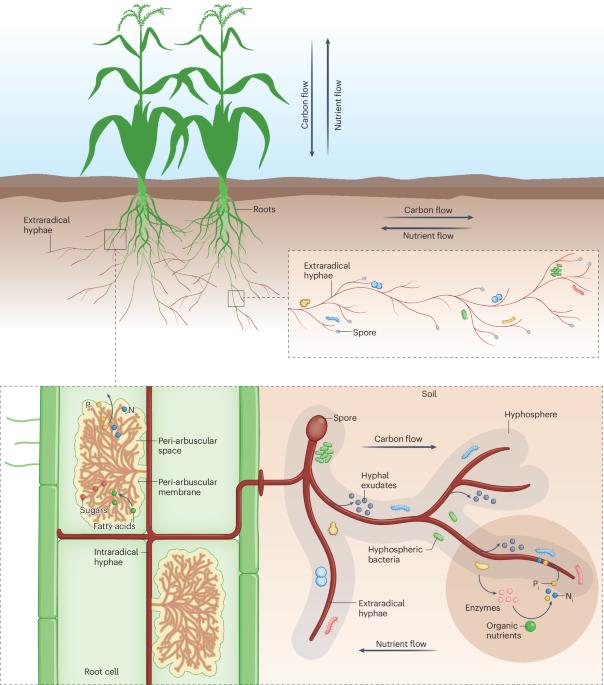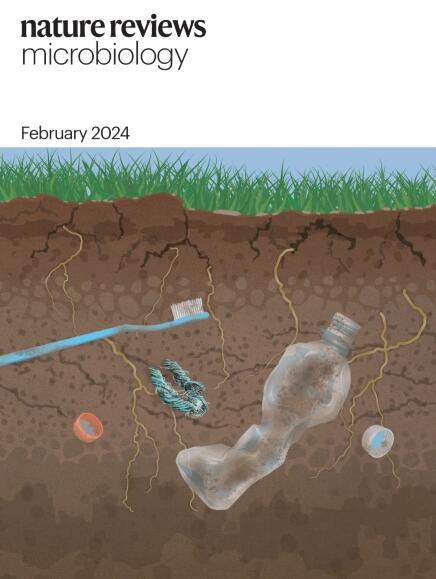植物-丛枝菌根真菌-细菌连续体中的跨领域养分交换
IF 103.3
1区 生物学
Q1 MICROBIOLOGY
引用次数: 0
摘要
植物与丛枝菌根真菌(AMF)之间的联系会影响植物的生长和生态系统的功能。最近的研究发现,AMF相关细菌是参与AMF-植物共生的合作伙伴:特定的内生细菌生活在AMF内部,而下层细菌则定殖在围绕着根外菌丝的土壤中。在本综述中,我们将阐述植物-AMF-细菌连续体的概念,总结当前的研究进展,并对土壤微生物学提出展望。首先,我们回顾了这一连续体中自上而下的碳流和自下而上的矿物质流(尤其是磷和氮),以及 AMF-细菌相互作用如何影响养分(如碳、磷和氮)的生物地球化学循环。其次,我们将讨论 AMF 如何与同温层细菌或内生细菌相互作用,以调节植物与 AMF 之间的养分交换,以及支撑这一连续体的可能分子机制。最后,我们探讨了对同温层进行研究以促进在可持续农业中利用 AMF 和同温层细菌的未来前景。本文章由计算机程序翻译,如有差异,请以英文原文为准。


Cross-kingdom nutrient exchange in the plant–arbuscular mycorrhizal fungus–bacterium continuum
The association between plants and arbuscular mycorrhizal fungi (AMF) affects plant performance and ecosystem functioning. Recent studies have identified AMF-associated bacteria as cooperative partners that participate in AMF–plant symbiosis: specific endobacteria live inside AMF, and hyphospheric bacteria colonize the soil that surrounds the extraradical hyphae. In this Review, we describe the concept of a plant–AMF–bacterium continuum, summarize current advances and provide perspectives on soil microbiology. First, we review the top-down carbon flow and the bottom-up mineral flow (especially phosphorus and nitrogen) in this continuum, as well as how AMF–bacteria interactions influence the biogeochemical cycling of nutrients (for example, carbon, phosphorus and nitrogen). Second, we discuss how AMF interact with hyphospheric bacteria or endobacteria to regulate nutrient exchange between plants and AMF, and the possible molecular mechanisms that underpin this continuum. Finally, we explore future prospects for studies on the hyphosphere to facilitate the utilization of AMF and hyphospheric bacteria in sustainable agriculture. Most plants form symbioses with arbuscular mycorrhizal fungi, which themselves harbour endobacteria and hyphospheric bacteria. In this Review, Duan et al. explore how nutrients are transferred between the partners in this plant–fungus–bacterium continuum.
求助全文
通过发布文献求助,成功后即可免费获取论文全文。
去求助
来源期刊

Nature Reviews Microbiology
生物-微生物学
CiteScore
74.00
自引率
0.50%
发文量
149
审稿时长
6-12 weeks
期刊介绍:
At Nature Reviews Microbiology, our goal is to become the leading source of reviews and commentaries for the scientific community we cater to. We are dedicated to publishing articles that are not only authoritative but also easily accessible, supplementing them with clear and concise figures, tables, and other visual aids. Our objective is to offer an unparalleled service to authors, referees, and readers, and we continuously strive to maximize the usefulness and impact of each article we publish. With a focus on Reviews, Perspectives, and Comments spanning the entire field of microbiology, our wide scope ensures that the work we feature reaches the widest possible audience.
 求助内容:
求助内容: 应助结果提醒方式:
应助结果提醒方式:


